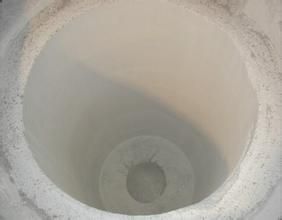What are the functions of coil glue?
The coil cement is pre-mixed with white corundum sand, powder as the matrix, and an appropriate amount of compound additives. The design considers fire resistance, insulation, and operability. Coil cement is the coating material for the inner and outer surfaces of the coreless induction coil. .It should be evenly coated on the inner and outer surface of the coil with a thickness of about 6 mm. It can be used as insulation between the coils. Add about 12%-14% water to achieve the uniformity of the painting. The product is affected by the initial hardening time Therefore, it is not advisable to mix too much material each time. Pour an appropriate amount of material into the container according to the construction amount each time, add 4.8% of the total dry material weight of clean tap water, stir evenly by hand or mechanically, and then put it into use.
Coil cement is used for the induction coil of the intermediate frequency coreless induction furnace. It is evenly coated on its surface and ramp, which has a good insulating effect. It is useful to avoid coil fire caused by coil aging and water leakage, and it is also useful to prevent molten steel from passing through the furnace due to excessive temperature. It is recommended to carry out minor repairs 8 hours before the furnace is air-dried. Major repairs or alterations to the new coil should be carried out on the furnace-making day.
Characteristics and functions of coil cement:
Coil glue has the characteristics of high strength, high density and high insulation. It is corundum sand glue, which is used to maintain the coil of coreless induction furnace. The coil glue has good viscosity and is very convenient to use. The lubricating surface coated on the coil can cushion The expansion and contraction of the working fabric. In addition, the coil slurry can effectively avoid the leakage of the metal melt and protect the coil from the breakdown of the metal melt.
Advantages of Coil Clay:
1. Insulation between coil turns.
2. The new coil can be coated or used as a correction material for the coil.
3. High thermal conductivity.
4. To a large extent, the generation and expansion of penetration can be avoided.

Previous: What are the common misunderstandings of ramming materials in intermediate frequency furnaces
Related Industry Knowledge
- Features and Benefits of Coil Clay
- What are the advantages of a good furnace lining
- Misunderstandings in the use of ramming materials in intermediate frequency furnaces
- Phenomenon analysis of failure of argon blowing of ladle permeable bricks and how to improve the rate of argon blowing
- Where is the consumption reduction and energy saving of breathable bricks reflected?
- How to improve the service life of intermediate frequency furnace lining
- Reasons for damage to intermediate frequency furnace lining and how to solve them
- The performance and advantages of breathable brick
- Analysis of Structural Characteristics of Dispersive Breathable Bricks
- The intermediate frequency furnace charge knotting process needs to pay attention to details sharing
- What are the common misunderstandings of ramming materials in intermediate frequency furnaces
- Intermediate frequency furnace ramming material through the furnace
- What is the knotting process of wear-resistant ramming material?
- Selection of Furnace Lining Material and Analysis of Factors Effectively Improving the Life of Electric Furnace
- Notes on the knotting process of wear-resistant ramming material
- What are the aspects of chemical corrosion of ramming materials?
- The conditions required for the selection of intermediate frequency furnace lining materials
- Another function of the ramming material, as a binder
- The effect of using ramming material
- Reasons for the stable quality and performance of breathable bricks


